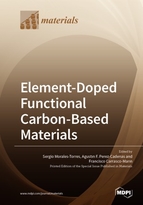Element-Doped Functional Carbon-based Materials
A special issue of Materials (ISSN 1996-1944). This special issue belongs to the section "Carbon Materials".
Deadline for manuscript submissions: closed (30 June 2019) | Viewed by 48562
Special Issue Editors
Interests: carbon materials; energy materials; electro-catalysis; energy storage; supercapacitors; heterogeneous catalysis; green chemistry and environmental chemistry
Special Issues, Collections and Topics in MDPI journals
Interests: carbon materials; carbon metal composites; carbon gels; photo-catalysis; electro-catalysis; catalytic combustion; hydrogenation reactions; advanced oxidation processes
Special Issues, Collections and Topics in MDPI journals
Interests: carbon nanostructures; graphene; nanostructured metal oxide; structured catalysts and membranes; chemical functionalization; advanced oxidation processes; air/water treatment; desalination
Special Issues, Collections and Topics in MDPI journals
Special Issue Information
Dear Colleagues,
Carbon materials are one of the most fascinating materials because of their unique properties and potential use in several applications. They can be obtained from residues or by using advanced synthesis technologies like chemical vapour deposition. The carbon family is very wide, it includes classical activated carbons to more advanced ones, like carbon nanomaterials. However, these materials possess an easily tuneable porosity or chemical characteristics, which determine their final application. The surface chemistry is one of the most interesting aspects of this broad family of materials which allows the incorporation of different types of chemical functionalities or heteroatoms on the carbon surface such as N, B, S, P modifying, the acid-base character or their electronic properties.
This Special Issue will deal with the recent advances in heteroatom-doped carbon materials. Different synthesis procedures, characterization techniques and applications for these functional materials will be covered, as well as novel insights can be proposed.
It is our pleasure to invite you to submit a manuscript for this Special Issue. Full papers, short communications, and reviews are welcome.
Prof. Dr. Francisco Carrasco-MarínProf. Dr. Agustín F. Pérez-Cadenas
Dr. Sergio Morales-Torres
Guest Editors
Manuscript Submission Information
Manuscripts should be submitted online at www.mdpi.com by registering and logging in to this website. Once you are registered, click here to go to the submission form. Manuscripts can be submitted until the deadline. All submissions that pass pre-check are peer-reviewed. Accepted papers will be published continuously in the journal (as soon as accepted) and will be listed together on the special issue website. Research articles, review articles as well as short communications are invited. For planned papers, a title and short abstract (about 100 words) can be sent to the Editorial Office for announcement on this website.
Submitted manuscripts should not have been published previously, nor be under consideration for publication elsewhere (except conference proceedings papers). All manuscripts are thoroughly refereed through a single-blind peer-review process. A guide for authors and other relevant information for submission of manuscripts is available on the Instructions for Authors page. Materials is an international peer-reviewed open access semimonthly journal published by MDPI.
Please visit the Instructions for Authors page before submitting a manuscript. The Article Processing Charge (APC) for publication in this open access journal is 2600 CHF (Swiss Francs). Submitted papers should be well formatted and use good English. Authors may use MDPI's English editing service prior to publication or during author revisions.
Keywords
- carbon materials
- heteroatoms
- doping
- surface chemistry, adsorption, catalytic applications, environmental applications, electrodes, energy storage









